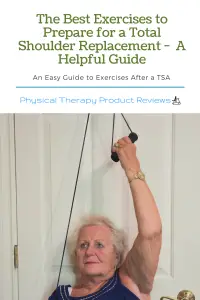 You’re on your way to restoring motion and getting rid of that pesky shoulder pain! Now that you know what is causing your shoulder pain and the shoulder is scheduled, what do you do now?
You’re on your way to restoring motion and getting rid of that pesky shoulder pain! Now that you know what is causing your shoulder pain and the shoulder is scheduled, what do you do now?
While you’re pending a total shoulder replacement, there are some exercises you can complete to better prep your shoulder for recovery.
Did you know that doing exercises before surgery helps speed up pain and recover after surgery?
Why should I do exercises before my surgery?
If you are awaiting a total shoulder replacement surgery, you’re likely experiencing symptoms like weakness, pain with range of motion, and pain while sleeping. Completing pre-habilitation before your surgery can help alleviate some of your pain and improve your function.
These conservative exercises will not restore your shoulder to normal function, but they can positively influence your symptoms and your post-op recovery.
Prepare for your Total Shoulder Replacement with these Exercises
Shoulder Pendulums
When Can you Start? After day 3 post surgery
- Lean forward near the side of a table or railing and use your unaffected arm to support yourself.
- Let your affected arm dangle down.
- Relax your arm completely and try not to perform any active motion in the shoulder during this exercise.
- Begin to rock your body back and forth so your hanging arm begins to swing gently.
- You want to try to achieve a circular rotation.
- Let your arm swing clockwise for 30 seconds, then reverse the rocking of your body to swing your arm counterclockwise for 30 seconds. Repeat 2-3 times and a few times throughout the day.
Video Link: https://www.youtube.com/watch?v=2m0UZM7-yCw
Why Pendulums?
You might be thinking, “Why am I doing this?!” Though it may feel like a silly exercise, pendulums are excellent at improving shoulder pain and edging you towards restoring normal motion!
This is a fantastic exercise to master before surgery because you’ll be doing a lot of them during your recovery.
Shoulder Isometrics
When can you start this exercise? The earliest is 3-4 weeks after surgery.
With your arm at your side, bend your elbow 90 deg and form your hand into a fist. Imagine that your fist is inside of a small box – you will be “pushing” against each plane of this box to gently activate the muscles of your shoulder. To provide the resistance, use your unaffected hand like so:
- Place your unaffected hand on top of your fist. Gently push your fist into your palm while you push your palm back into your fist.
- Place your palm on the front of your fist. Gently push forward into the palm, resisting the pressure back.
- Place your palm on the inside of your fist. Gently push into your palm, as if you were trying to rotate your arm across your body.
- Place your palm on the outside of your fist. Gently push outward into your palm as if you were trying to rotate your arm out to the side.
- Hold each resistance for 3-5 seconds, then relax. Perform 5 repetitions of each plane of motion.
Video Link: https://www.youtube.com/watch?v=qQjjc3UlKCY
Why Shoulder Isometrics?
Isometrics are a great way to wake up the muscles of your shoulder without adding the stress of extra weight or range of motion, which may flare up your symptoms.
Scapular Squeezes
When can you start this? After day 3 post surgery
- Sit up tall, with good posture.
- Tighten the muscles of your upper back as you squeeze your shoulder blades together.
- Hold for a few seconds, then relax. Perform 10-15 repetitions a few times a day.
Video Link: https://www.youtube.com/watch?v=WklUZWulQao
Why Scapular Squeezes?
The scapula, or shoulder blade, is an integral part of your shoulder! Scapular squeezes can strengthen your upper back and encourage good range of motion.
Upper Trap Stretch

When Can you start these exercises? After 3 days post-surgery with your non-surgical arm.
- Sit up tall, with good posture.
- Slowly tilt your head to the side, away from your affected shoulder.
- You should feel a stretch along your upper shoulder and neck.
- Hold for 20 seconds, then release. Repeat for 3 iterations.
Why Trap Stretches?
The trapezius muscle plays an important role in shoulder strength and range of motion. It tends to get very tight and symptomatic in patients with shoulder dysfunction.
Shoulder Wall Walks
When can you start this exercise? Once you are cleared to get rid of your shoulder brace.
- Stand facing a wall.
- Using your affected arm, slowly walk your fingers up the wall – staying within your tolerance level for a range of motion.
- When you reach the peak of your motion, hold for a few seconds, then slowly walk your fingers back down the wall.
- Turn your body perpendicular to the wall and repeat, raising your arm out to the side as you finger walk up.
- Repeat a few times on each side.
Video Link: https://www.youtube.com/watch?v=V7-M7UONtwI
Why Wall Walks?
This exercise is a great way to work on range of motion without stressing out painful muscles. A few weeks into your post-op rehab, this will be a very common exercise!
Other Great Shoulder Exercises
You can complete any exercise that doesn’t further aggravate your shoulder pain. Make sure you practice good form and don’t overdo it.

Try the following exercises, if you need more of a challenge if you are 8 weeks after surgery:
- Light resistance band work (Shoulder 6-Way): aim for completing more reps, versus using heavier weights.
- Resistance band rows: stay within your comfortable range of motion.
- Wall planks: perform front and side planks using a wall (or the back of your couch) for support.
- Aquatics: no, you don’t need to freestyle down the lane, but using the water to take the pressure off of your muscles, you may find that moving your shoulder is easier and less painful.
Pre-Op Shoulder Exercises
Conclusion
There’s a lot you can do while you wait for your total shoulder replacement surgery. Remember to keep the exercises within your tolerance level and cease them after you undergo surgery. At this point, your physical therapist will guide you in a structured rehab program.
Works Referenced:
Athwal GS, Elliott T. Shoulder surgery exercise guide. American Academy of Orthopaedic Surgeons. 2017. https://orthoinfo.aaos.org/en/recovery/shoulder-surgery-exercise-guide/
Villers JF, Burch J, Scheller M, Huang H. Physical therapy prehabilitation on a reverse total shoulder replacement candidate: a case study. Journal of Physical Therapy Science. 2020; 32(2):197-205. https://www.ncbi.nlm.nih.gov/pmc/articles/PMC7032973/
How to Stay Active After Cervical Fractures: Expert Tips and Advice
Dealing with Painful Stairs After Ankle Replacement Surgery
Walking After a Total Ankle Replacement: Tips for a Successful Recovery
Exercises While Non-Weight Bearing After Ankle Replacement: Elevation, AROM, Leg Raises, and More
Ankle Pain with Stairs: Causes and Home Treatment Options
5 Common Mistakes You’re Making After an Ankle Sprain
Disclaimer: The information provided in this post is for educational purposes only. This is not a substitute for a medical appointment. Please refer to your physician before starting any exercise program.






